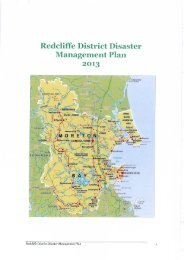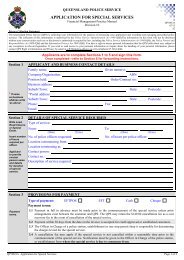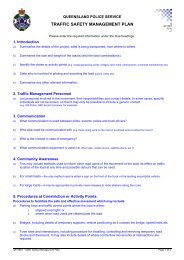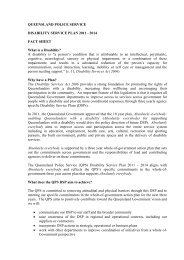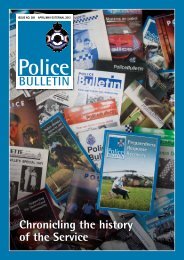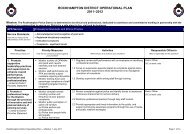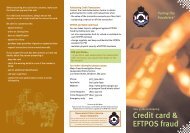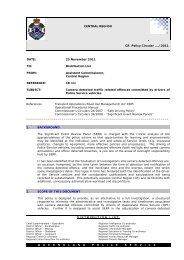Alcohol Drugs and the Law, for parents - Queensland Police Service
Alcohol Drugs and the Law, for parents - Queensland Police Service
Alcohol Drugs and the Law, for parents - Queensland Police Service
You also want an ePaper? Increase the reach of your titles
YUMPU automatically turns print PDFs into web optimized ePapers that Google loves.
FOR PARENTS
Patterns <strong>and</strong><br />
context of alcohol/<br />
o<strong>the</strong>r drug use by<br />
young Australians.<br />
Legal<br />
aspects<br />
of alcohol<br />
<strong>and</strong> o<strong>the</strong>r<br />
drug use.<br />
The harms<br />
associated with<br />
alcohol <strong>and</strong><br />
o<strong>the</strong>r drug use.<br />
How to reduce<br />
<strong>the</strong> risk of your<br />
child experiencing<br />
alcohol <strong>and</strong> o<strong>the</strong>r<br />
drug-related<br />
consequences.<br />
<strong>Alcohol</strong> <strong>and</strong> o<strong>the</strong>r drug use by young Australians is common:<br />
■ 34% of 12-17 year old high school students report<br />
consuming alcohol in <strong>the</strong> past week, <strong>and</strong> 10% have<br />
consumed alcohol at risky or high-risk levels in <strong>the</strong> past<br />
week. Most high school students drink alcohol in <strong>the</strong> home,<br />
at a friend’s house, or at parties. (Source: National Drug<br />
Strategy, 2004. Australian secondary students’ use of<br />
alcohol in 2002)<br />
■ 13.5% of 14-19 year olds smoke tobacco. [Source:<br />
Australian Institute of Health <strong>and</strong> Welfare (AHIW), 2005.<br />
2004 National Drug Strategy Household Survey.]<br />
■ 18% of 14-19 year olds have used cannabis in <strong>the</strong> last 12<br />
months, <strong>and</strong> 89.1% of cannabis use occurs in <strong>the</strong> home or a<br />
friend’s home. (Source: AHIW, 2005).<br />
■ about 4.3% of 14-19 year olds have used amphetamine-<br />
like substances (‘meth’, ‘speed’) in <strong>the</strong> last 12 months.<br />
The powder <strong>for</strong>m is <strong>the</strong> most commonly used (74.3% of<br />
users), <strong>and</strong> <strong>the</strong> most common settings of use include in <strong>the</strong><br />
home, private or dance parties, <strong>and</strong> public establishments.<br />
(Source: AHIW, 2005).<br />
■ about 4.3% of 14-19 year olds have used MDMA (‘ecstasy’)<br />
in <strong>the</strong> last 12 months, <strong>and</strong> 26.1% of <strong>the</strong>se have used MDMA<br />
once a month or more. 63.3% of use occurs at rave/dance<br />
parties. (Source: AHIW, 2005).<br />
■ about 4% of young people have illegally used prescribed<br />
medication (painkillers, tranquilisers, barbiturates, or<br />
steroids) in <strong>the</strong> last 12 months. (Source: AHIW, 2005).<br />
DEFINITIONS FOR<br />
SHORT-TERM ALCOHOL-<br />
RELATED HARM:<br />
Risky alcohol use = 7-10<br />
st<strong>and</strong>ard drinks (<strong>for</strong> males)<br />
or 5-6 st<strong>and</strong>ard drinks (<strong>for</strong><br />
females) on at least one<br />
occasion in <strong>the</strong> last week.<br />
High-risk alcohol use = 11+<br />
st<strong>and</strong>ard drinks (<strong>for</strong> males)<br />
or 7+ st<strong>and</strong>ard drinks (<strong>for</strong><br />
females) on at least one<br />
occasion in <strong>the</strong> last week.<br />
These are <strong>for</strong> adults, <strong>and</strong><br />
definitions may be more<br />
conservative <strong>for</strong> children.<br />
[St<strong>and</strong>ard drink = 10gms<br />
of ethanol, which is<br />
approximately equal to<br />
a 30ml nip of spirits, a<br />
restaurant sized glass of<br />
wine, or a ‘pot’ of beer.]<br />
[Source: National Health<br />
<strong>and</strong> Medical Research<br />
Council, 2001. Australian<br />
alcohol guidelines: Health<br />
risks <strong>and</strong> benefits.]<br />
1
2<br />
If your child is using<br />
drugs, <strong>the</strong>y are at<br />
risk of harm. Even<br />
if <strong>the</strong>y have never<br />
used drugs, <strong>the</strong>re is<br />
a good chance that<br />
<strong>the</strong>y will encounter<br />
situations where<br />
<strong>the</strong>re are pressures<br />
to try different<br />
drugs, or at <strong>the</strong><br />
very least, be<br />
around o<strong>the</strong>rs who<br />
are experimenting.<br />
VOLATILE<br />
SUBSTANCE MISUSE<br />
Just over 1% of 14-19 year<br />
olds of young people have<br />
inhaled vapours or fumes<br />
of volatile substances<br />
(e.g., paint, glues, fuels)<br />
in <strong>the</strong> previous 12 months<br />
(Source: AHIW, 2008).<br />
Volatile substances, like<br />
o<strong>the</strong>r drugs, have a range<br />
of risks associated with<br />
<strong>the</strong>ir use.<br />
What harms are associated with risky or high-risk drinking <strong>and</strong><br />
o<strong>the</strong>r drug use? Harms vary according to many factors (e.g., <strong>the</strong><br />
drug type <strong>and</strong> amount consumed, <strong>the</strong> context, <strong>and</strong> individual<br />
factors), but can include:<br />
■ being physically or sexually assaulted, assaulting o<strong>the</strong>rs,<br />
drowning, or being injured (e.g., in a motor vehicle accident).<br />
■ medical complications (e.g., damage to <strong>the</strong> liver, brain, lungs),<br />
coma, <strong>and</strong> death.<br />
■ experimentation with additional drugs. <strong>Alcohol</strong> <strong>and</strong> o<strong>the</strong>r drugs<br />
can interact with each o<strong>the</strong>r to worsen <strong>the</strong> effects of each drug<br />
taken individually.<br />
■ problems with social, school, <strong>and</strong>/or family relationships (e.g.,<br />
conflict with <strong>parents</strong>, becoming involved with peer groups that<br />
foster heavy drinking <strong>and</strong> o<strong>the</strong>r drug use).<br />
■ scholastic per<strong>for</strong>mance problems (in part due to erosion of<br />
motivation, memory <strong>and</strong> learning).<br />
■ psychiatric problems, including alcohol/drug dependence,<br />
psychosis, anxiety/depression, <strong>and</strong> schizophrenia in people<br />
with a family history of mental illness.<br />
■ Drug use may also bring young people into contact with <strong>the</strong><br />
police <strong>and</strong> <strong>the</strong> courts. This contact can have significant social<br />
<strong>and</strong> personal consequences.<br />
Young people (under 18 years of age) are committing<br />
an offence if <strong>the</strong>y:<br />
■ consume alcohol or are in possession of alcohol<br />
in licensed premises or a public place.<br />
■ give alcohol to o<strong>the</strong>r people who are under 18 in<br />
a licensed premise or public place.<br />
■ send someone else who is under 18 to buy alcohol.<br />
■ use someone else’s ID to try to purchase alcohol<br />
or to gain entry to licensed premises.<br />
■ are being a public nuisance.<br />
■ possess, produce or supply illegal drugs<br />
(this includes growing cannabis).<br />
■ publish or possess a recipe <strong>for</strong> <strong>the</strong> production of a<br />
dangerous drug.<br />
■ possess equipment (e.g., a bong or cannabis pipe) used,<br />
or <strong>for</strong> use, with an illegal drug.<br />
■ drive a vehicle whilst being unlicensed, or <strong>the</strong> holder of<br />
a learner, probationary or provisional license <strong>and</strong> have a<br />
blood alcohol level greater than zero.<br />
■ sell tobacco to someone under 18 years of age.<br />
■ unlawfully give someone prescription drugs (unless you<br />
are a doctor or pharmacist).<br />
THERE ARE THREE MAIN<br />
CATEGORIES OF DRUG<br />
OFFENCES :<br />
■ Possession<br />
■ Sale/supply<br />
■ Production<br />
The penalties associated<br />
with <strong>the</strong>se offences depend<br />
on <strong>the</strong> type of drug involved<br />
<strong>and</strong> <strong>the</strong> quantity recovered.<br />
3
Liquor license<br />
holders <strong>and</strong> <strong>the</strong>ir<br />
employees who<br />
sell alcohol to<br />
people under 18<br />
years of age are<br />
also breaking <strong>the</strong><br />
law <strong>and</strong> can face<br />
heavy penalties.<br />
It is not an offence:<br />
■ <strong>for</strong> a person under 18 to drink alcohol responsibly within your<br />
property, or someone else’s private property but <strong>the</strong>y have to<br />
be supervised by a responsible adult. If minors are unduly<br />
intoxicated or not being responsibly supervised police may seize<br />
<strong>the</strong> liquor. However, young people, like adults, can be arrested<br />
<strong>for</strong> behaviours associated with drinking (such as violence,<br />
property damage).<br />
■ <strong>for</strong> a young person to be at a party where illegal drugs are<br />
present, provided <strong>the</strong>y have not consumed or been in possession<br />
of any illegal drugs. They may be questioned by police if found<br />
at a party where <strong>the</strong>re are illegal drugs, <strong>and</strong> <strong>the</strong>y may still be at<br />
risk of harm even if <strong>the</strong>y have not consumed drugs.<br />
■ <strong>for</strong> a young person to inhale volatile substances, however, this<br />
misuse can cause significant <strong>and</strong> long-term health problems.<br />
If <strong>the</strong> police know, or reasonably suspect, that a volatile<br />
substance is being inhaled, it can be confiscated. Anyone<br />
affected by consuming or inhaling a potentially harmful<br />
substance may also be brought home or to ano<strong>the</strong>r place of<br />
safety by police.<br />
Are <strong>the</strong>re laws involving drug use by young people that make<br />
<strong>parents</strong>/guardians legally responsible?<br />
In general, <strong>parents</strong>/guardians (like o<strong>the</strong>r adults) are<br />
committing an offence if <strong>the</strong>y:<br />
■ supply alcohol to a person under 18 in a licensed premise<br />
or public place or irresponsibly in a private place.<br />
■ send a person under 18 to buy alcohol.<br />
■ supply alcohol to a person under 18 if <strong>the</strong>y are not being<br />
responsibly supervised<br />
■ allow <strong>the</strong>ir home or o<strong>the</strong>r place under <strong>the</strong>ir control to be<br />
used <strong>for</strong> possessing, supplying or producing illegal drugs.<br />
What happens if a young person (under 17 years of age)<br />
commits an illegal drug-related offence <strong>and</strong> is<br />
arrested by police?<br />
Their <strong>parents</strong>/guardians may be notified. If <strong>the</strong> arrest occurs<br />
away from home, <strong>the</strong> young person may be brought home or<br />
taken to ano<strong>the</strong>r place of safety. The young person may be taken<br />
by police <strong>for</strong> questioning. Parents or ano<strong>the</strong>r support person<br />
would normally be requested to attend such an interview, if <strong>the</strong><br />
person is under 17 years of age at <strong>the</strong> time. The young person<br />
may be fingerprinted <strong>and</strong> photographed, <strong>and</strong> under certain<br />
circumstances, a young person may be searched by police.<br />
Some searches of persons under 17 years of age may require<br />
<strong>the</strong> presence of a parent or ano<strong>the</strong>r support person.<br />
A young person may be cautioned, diverted, or charged. If <strong>the</strong>y<br />
commit an offence <strong>the</strong> police may:<br />
■ caution <strong>the</strong> young person. This involves a <strong>for</strong>mal warning by<br />
<strong>the</strong> police, in which a notice of caution may be issued.<br />
■ offer a referral to a drug diversion assessment program (<strong>for</strong><br />
cannabis related offences). This program normally consists<br />
of a 2-hour session with a health worker <strong>and</strong> includes an<br />
assessment of drug use, education <strong>and</strong> counselling.<br />
■ charge <strong>the</strong> young person. In this event, <strong>the</strong> young person<br />
would normally be required to attend a court hearing. This<br />
may involve bail. If convicted, sentences depend on <strong>the</strong> type<br />
of drug, type of activity (possession, sale, or production),<br />
<strong>and</strong> <strong>the</strong> quantity found.<br />
What are <strong>the</strong> long-term<br />
consequences of a<br />
conviction?<br />
In Queensl<strong>and</strong>, laws<br />
governing most <strong>for</strong>ms of<br />
drug use, <strong>and</strong> <strong>the</strong> penalties<br />
<strong>for</strong> misusing drugs, can<br />
be harsh. Convictions are<br />
recorded <strong>for</strong> some offences<br />
<strong>and</strong> can have a negative<br />
impact on a young person’s<br />
future. A conviction <strong>for</strong> a<br />
drug offence may affect<br />
<strong>the</strong> type of job that a young<br />
person can aspire to,<br />
holding certain licenses as<br />
an adult, or <strong>the</strong>ir chances<br />
of getting a visa <strong>for</strong> entry<br />
into some countries. Even<br />
where convictions are not<br />
recorded, <strong>the</strong> offence may<br />
still have an impact on what<br />
a young person can <strong>and</strong><br />
cannot do. For example,<br />
obtaining a Blue Card to<br />
work with children involves<br />
checking both recorded <strong>and</strong><br />
unrecorded convictions.<br />
4 5
6<br />
Be aware…<br />
■ Parties are one of <strong>the</strong> most common settings in which young<br />
people will encounter drugs. Brochures <strong>and</strong> o<strong>the</strong>r in<strong>for</strong>mation<br />
are available on safe parties <strong>for</strong> young people (see Resources).<br />
■ If young people are on your property, you may be liable <strong>for</strong> <strong>the</strong>ir<br />
safety. If a young person suffers trauma or injury under your care,<br />
you could face liability through civil proceedings against you.<br />
■ Boys <strong>and</strong> girls differ in <strong>the</strong> risks <strong>the</strong>y are exposed to when at<br />
venues where alcohol <strong>and</strong> o<strong>the</strong>r drugs are being consumed.<br />
Young women may be at greater risk of unwanted sexual<br />
attention, coercion, or sexual assault. Young men are at<br />
greater risk of damaging property <strong>and</strong>/or personal violence.<br />
■ Drink “spiking” (adding alcohol, sedatives, or o<strong>the</strong>r drugs to a<br />
person’s drink without <strong>the</strong>ir awareness) is a criminal act that<br />
can occur in a range of settings including hotels, nightclubs<br />
<strong>and</strong> private parties.<br />
■ Young people under <strong>the</strong> age of 16 cannot legally consent to<br />
sexual relations. <strong>Alcohol</strong> <strong>and</strong> o<strong>the</strong>r drug use can erode a young<br />
person’s judgment in making decisions on this issue.<br />
Parents <strong>and</strong> guardians have important roles in protecting children<br />
from situations where alcohol <strong>and</strong> o<strong>the</strong>r drug misuse can start, <strong>and</strong><br />
from harm that can result from <strong>the</strong>ir misuse. These roles include<br />
clear <strong>and</strong> effective communication with your child, planning <strong>for</strong> risky<br />
situations, <strong>and</strong> being aware of who your child is socialising with.<br />
Prevent problems by effectively communicating with your<br />
child about alcohol <strong>and</strong> o<strong>the</strong>r drugs.<br />
■ In preparation <strong>for</strong> talking with your child, make sure that<br />
you <strong>and</strong> your partner agree on <strong>the</strong> rules <strong>and</strong> expectations<br />
about alcohol <strong>and</strong> o<strong>the</strong>r drugs so that your messages are<br />
consistent. Choose <strong>the</strong> right time to do this – <strong>the</strong> hour<br />
be<strong>for</strong>e <strong>the</strong>y are going out may not be <strong>the</strong> best time.<br />
■ Set clear rules <strong>and</strong> expectations with your child about what<br />
sort of behaviour is acceptable <strong>and</strong> what is not.<br />
■ Occasionally revisit <strong>the</strong> above agreements with your child,<br />
<strong>and</strong> monitor <strong>the</strong>ir experiences of when <strong>the</strong>se rules <strong>and</strong><br />
expectations might have been tested.<br />
■ Reach agreement on <strong>the</strong> time that <strong>the</strong>y are to arrive home.<br />
Communicate <strong>the</strong> importance of sticking closely to<br />
that time.<br />
■ Reach agreement on <strong>the</strong> way your child is to get home, <strong>and</strong><br />
who might accompany <strong>the</strong>m home. Discourage <strong>the</strong>m from<br />
walking home alone.<br />
■ Older siblings are important role models <strong>for</strong> young people.<br />
Take <strong>the</strong> time to talk through with <strong>the</strong> older sibling about<br />
your concerns <strong>and</strong> expectations, <strong>and</strong> reach agreement<br />
on expectations.<br />
7
8<br />
Agree with your child on ‘back-up’ plans <strong>for</strong> risky situations.<br />
■ Discuss what <strong>the</strong>y should do if <strong>the</strong>re are unexpected delays or<br />
problems with getting home, including how <strong>the</strong>y might contact<br />
you to let you know of <strong>the</strong> delay or problem.<br />
■ Agree on an early detection <strong>and</strong> escape plan <strong>for</strong> dangerous<br />
situations. Make sure this plan is clear in your child’s mind.<br />
Sexual coercion <strong>and</strong> assault is an especially significant risk<br />
<strong>for</strong> young women.<br />
■ Let <strong>the</strong>m know that you are prepared to go <strong>and</strong> pick <strong>the</strong>m up.<br />
While this can be inconvenient, it can reduce <strong>the</strong> risk of assault<br />
<strong>and</strong> o<strong>the</strong>r problems.<br />
■ Keep communication lines open so that if your child is <strong>the</strong><br />
victim of a criminal offence, he/she feels safe to disclose<br />
such an event to you or ano<strong>the</strong>r authority figure (e.g., school<br />
guidance officer, telephone counsellor, or <strong>the</strong> police).<br />
Know your child’s friends.<br />
■ Be aware of who your child’s friends are. If you suspect that<br />
<strong>the</strong>y are using drugs, communicate to your child that your<br />
interest is in protecting <strong>the</strong>ir health <strong>and</strong> well-being, <strong>and</strong><br />
explore ways of reducing any pressures to misuse alcohol <strong>and</strong>/<br />
or o<strong>the</strong>r drugs.<br />
■ Encourage a strong sense of responsibility in your child to look<br />
after friends who are at risk of alcohol or o<strong>the</strong>r drug-related<br />
harm. For example, your child could facilitate an early <strong>and</strong><br />
safe exit <strong>for</strong> a friend who is intoxicated.<br />
<strong>Alcohol</strong> <strong>and</strong> Drug In<strong>for</strong>mation <strong>Service</strong><br />
Telephone counseling service<br />
Telephone (07) 3837 5989 – Brisbane area<br />
1800 177 833 – toll free outside Brisbane<br />
Queensl<strong>and</strong> <strong>Police</strong> <strong>Service</strong><br />
Crime Stoppers<br />
Toll free: 1800 333 000<br />
In<strong>for</strong>mation on safe parties<br />
http://www.police.qld.gov.au/party<br />
Drug <strong>and</strong> <strong>Alcohol</strong> In<strong>for</strong>mation<br />
http://www.police.qld.gov.au/services/drugs/coord.htm<br />
Australian Drug In<strong>for</strong>mation Network (ADIN)<br />
http://www.adin.com.au<br />
This brochure contains general comments only <strong>and</strong> should not<br />
be relied upon as specific advice. The contents do not constitute<br />
legal advice. Formal legal advice should be obtained <strong>for</strong><br />
particular matters.<br />
Produced by Queensl<strong>and</strong> <strong>Police</strong> <strong>Service</strong>, Drug & <strong>Alcohol</strong><br />
Coordination, (07) 3364 4601, February 2009.<br />
Funding provided by <strong>the</strong> National Drug Strategy <strong>Law</strong> En<strong>for</strong>cement Funding Committee.<br />
This brochure was developed in consultation with Adrian Kelly PhD <strong>and</strong> Christine Bond PhD<br />
from <strong>the</strong> School of Social Science, The University of Queensl<strong>and</strong>.
Cert no. SGC-COC-XXXX<br />
This publication is printed onto Sumo Satin (FSC certified paper)<br />
using an environmentally friendly waterless press





